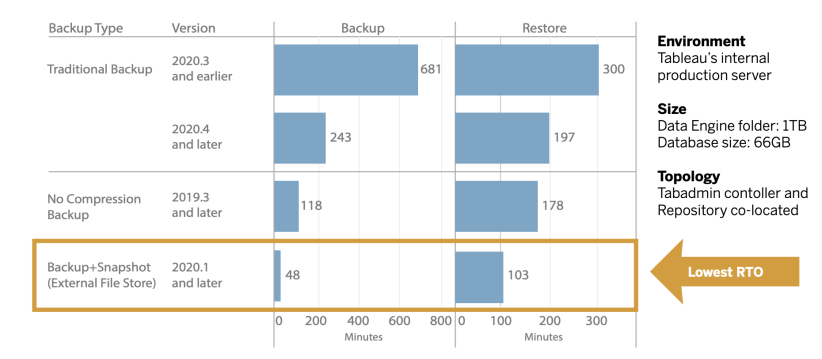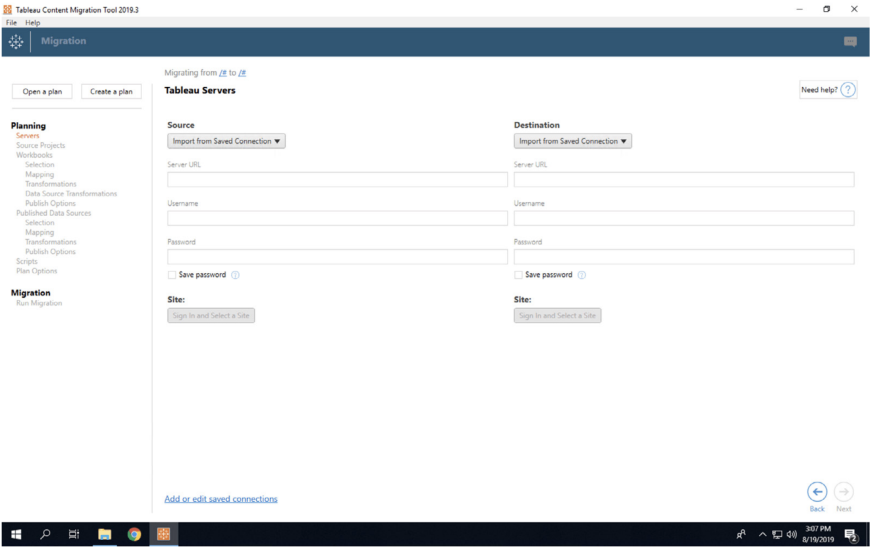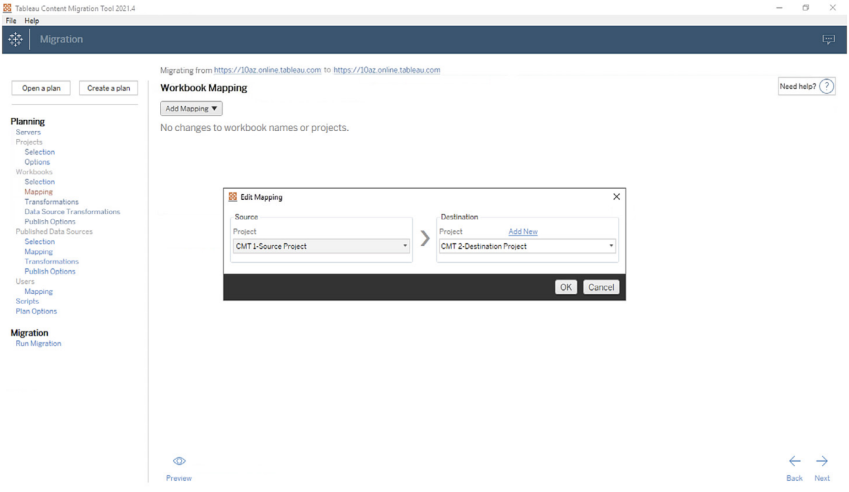Tableau Advanced Management
This content is part of Tableau Blueprint—a maturity framework allowing you to zoom in and improve how your organization uses data to drive impact. To begin your journey, take our assessment(Link opens in a new window).
As a Tableau deployment grows across an organization and serves more users and use cases, Tableau transitions from an application that is used in small workgroup scenarios, to a business-critical enterprise platform that is managed and governed by IT. Additional controls, security, and governance measures must be implemented to support the platform as an enterprise-wide service.
Tableau Advanced Management brings together manageability, security, and scalability capabilities for customers running Tableau in mission-critical use cases. Advanced Management’s highly configurable capabilities make it easier to understand your Tableau ecosystem and meet tough security requirements while delivering an improved end-user experience. This leads to increased agility and significant time savings for IT.
Advanced Management is available for both Tableau Server and Tableau Cloud and is licensed separately from your Tableau Server or Tableau Cloud deployment.
Click into the following sections to learn more about Advanced Management for Tableau Server or Tableau Cloud based on your deployment.
Advanced Management for Tableau Server
Advanced Management for Tableau Server is separately licensed for Tableau Server or bundled with Data Management as part of the Enterprise Subscription Plan, providing enhanced security, manageability, and scalability capabilities. The offering brings together additional cluster configuration options, agent-based cluster monitoring, and content migration capabilities to meet specific deployment and workflow requirements.
Configuration Management
Advanced Management for Tableau Server delivers deeper integration with AWS, Azure, GCP, and on-premises deployment types, allowing you to further leverage your technology investments and expertise. The table below shows the capability and corresponding cloud service or on-prem infrastructure.
|
|
AWS |
Azure |
GCP |
On-premises |
|---|---|---|---|---|
|
External File Store |
Amazon EFS or FSx |
Azure File Store |
Google Filestore |
NAS |
|
External Repository |
Amazon RDS for PostgreSQL |
Azure Database for PostgreSQL |
Cloud SQL for PostgreSQL |
PostgreSQL database |
|
Key Management |
AWS KMS |
Azure Key Vault |
- |
- |
| Independent Gateway | AWS EC2 | Azure VM | Google Compute Engine VM | Additional node |
External File Store streamlines your deployment topology by centralizing the File Store on your enterprise-class storage system, eliminating the need to run local File Stores on multiple nodes in a Tableau Server cluster, and reducing network traffic during replication across nodes. If you are experiencing disk space constraints or high network traffic from node-to-node replication, you should consider implementing External File Store. For more information, see Tableau Server External File Store.

External Repository provides increased scalability and high availability for organizations with large amounts of Tableau metadata by separating the PostgreSQL database from the default, local PostgreSQL database installation so that you can manage it outside of Tableau with your other database maintenance processes. AWS and Azure configurations offer enhanced scalability, reliability, high availability and security leveraging the speed and scale of the cloud. For on-premises deployments, you can manage it using a self-managed PostgreSQL instance. For more information, see Tableau Server External Repository.
With Key Management, you can centralize your key management efforts and unlock more advanced security and compliance scenarios. The provides enhanced security by removing the master encryption key from the Tableau Server file system and storing it in the AWS or Azure platforms’ secure key management solution. For more information, see Key Management System.
Disaster Recovery
Utilizing external storage enables administrators to take snapshot backups of Tableau data if the storage device supports hardware snapshotting. This significantly reduces the time it takes to do a Tableau backup and restore. The result is a lower Recovery Time Objective (RTO) for disaster recovery.
Because backup is also a recommended part of the upgrade process, you will also achieve faster upgrades. Using one illustrative data point, Tableau’s internal Tableau Server deployment with a 1TB Data Engine folder and 66GB Repository completed a backup in less than 20% of the time it took with the default configuration, enabling an entire upgrade to be completed in less than 4 hours. For more information, see Backup and Restore with File Store.
Workload Management
When your background jobs increase as the number of extract refreshes and subscriptions grow, you may see job queueing. As a result, your users may not have access to the most current data, and they could experience delayed subscription delivery. Tableau Advanced Management enables you to configure node roles so that you can optimize backgrounder workload management by dedicating specific cluster resources to each type of job.
Backgrounder node roles for extract refreshes, subscriptions, and any combination related to extract refreshes and subscriptions alongside flow-only nodes with Tableau Data Management for flow execution provide greater control over workloads. By isolating these workloads to specific nodes, it's easier to scale your deployment to the needs of your organization. For more information, see Workload Management through Node Roles.
Monitoring & Chargebacks
As more users are on-boarded and the use of analytics grows across your organization, Tableau becomes mission-critical for data-driven decisions. Without monitoring, a “set-it-and-forget-it” deployment can be met with inadequate resources that fail to support the workload of highly-engaged users. Ongoing, proactive monitoring is required to operate and support your deployment at scale and meet the expectations of your user community.
Resource Monitoring Tool is an agent-based monitoring solution that offers deep insights into the health and performance of a Tableau Server cluster by parsing and analyzing the logs generated by system usage and combining that with monitoring of physical system usage (CPU Usage, RAM, Disk I/O etc.). As an administrator, you can define threshold alerts from environment, performance, and workload data that is aggregated from all your Tableau Server environments, as well as trace activity down to the user or session-level to isolate issues faster. With increased visibility into hardware utilization, VizQL sessions, data source queries, backgrounder workloads and more, it’s easier to manage the health of your Tableau Server deployment and precisely tune the performance of your server.

To manage and distribute analytics costs on your shared-infrastructure Tableau deployment within your organization, RMT includes chargeback modeling, which is especially useful if analytics is not handled through centralized accounting under one cost center. Chargeback reports show usage on a per-site or per-project basis.
The report is generated as a Tableau workbook, allowing you to modify the report or reuse the data as needed. The chargeback workbook shows a breakdown of various metrics based on site and/or project. This allows you to customize total cost to chargeback, adjust chargeback weight for each metric, and generate an invoice-style formatted view.
Content Management
Content Management, which is part of your Content Governance in Tableau practices, is key to enabling the effective use of data and analytics. Without content management, users will find it increasingly difficult to find what they need among irrelevant, stale, or duplicate workbooks and data sources. The Content Migration Tool automates tasks such as content promotion and archiving, supporting both traditional and modern workflows or anywhere in between.
With a codeless, streamlined, and repeatable migration plan, you can copy or migrate content between projects on a single Tableau Server installation, or if you have user-based licensing, between projects on separate Tableau Server installations (for example, from a development instance of Tableau Server to a production instance).
The Content Migration Tool User Interface walks you through the steps necessary to build a migration plan that you can use a single time or schedule for repeated migrations. In addition, you can remap data sources and perform other workbook transformations. For more information, see Content Migration Tool and Content Migration Tool Use Cases.

Advanced Management for Tableau Cloud
Advanced Management for Tableau Cloud makes it easy to quickly manage, secure, and scale mission-critical analytics, saving administrators time. Advanced Management is separately licensed for Tableau Cloud, delivering manageability, security, and scalability capabilities. Advanced Management helps you:
• Understand your environment. Keep your finger on the pulse of your Tableau deployment with operational insight features.
• Manage content at scale. Seamlessly promote content for your robust content lifecycle management needs.
• Enhance security. Meet organizational security requirements with more control over your data encryption keys.
• Scale for your enterprise. Leverage increased site capacity in Tableau Cloud to ensure users have access to the data they need to make data-backed decisions
Understand your environment
As more people use Tableau, it becomes a business-critical application for your organization. Users expect an easy to navigate, governed, and curated experience. When administrators take a passive, nonchalant approach to their deployment, they often fail to properly meet expectations resulting in poor adoption—and fewer data-driven decisions. Proactive, in-depth monitoring is required to manage your Tableau Cloud deployment at scale and keep your users engaged.
Fortunately, Advanced Management for Tableau Cloud improves and simplifies monitoring efforts, allowing you to track user actions and adoption over time. With the Activity Log and up to 365 days of data in Admin Insights, you can easily manage your Tableau Cloud ecosystem.
The Activity Log goes above and beyond existing monitoring data by providing detailed event data to help administrators track how individuals are using Tableau. Once the Activity Log is configured, you will receive a JSON file in an AWS S3 bucket every hour allowing you to integrate Tableau Cloud usage data with your security information and event management solution. You can use the Activity Log to conduct permissions auditing, verifying that users have access to appropriate content.
Admin Insights is a Tableau Cloud project that comes with a prebuilt Admin Insights Starter workbook and curated data sources. With Advanced Management, Admin Insights retains data for up to 365 days allowing you to better track site adoption, viz performance, and publishing-related activity over time.

Whether you choose to leverage the prebuilt content or build custom admin views, more data allows you to easily answer historical questions like:
-
Who is building the most Tableau content?
-
Who hasn’t logged in the last 100 days?
-
What are the most used views and data sources?
-
What content isn’t being used anymore?
Answering these questions allows you to not only improve the user experience and grow adoption across your Tableau ecosystem, you can also identify internal champions. These champions can share best practices with others, reach out to users who may need help getting started, show the return on your investments into workbooks and data sources, and remove stale content so users can easily find what they need.
Manage content at scale
Content management, a key component of your content governance practices, is essential to enable the effective use of data and analytics by everyone across your organization. Without content management, people will find it increasingly difficult to find what they need among irrelevant, stale, or duplicate workbooks and data sources. The Content Migration Tool automates tasks like content promotion and archiving, ensuring you can meet your organization’s content lifecycle requirements and deliver a superior user experience.
Content management doesn’t have to be hard. For example, with a codeless, streamlined, and repeatable migration plan, you can easily promote content between development and production projects in Tableau Cloud. During the content promotion process, you can remap data sources and perform other workbook transformations before sharing the workbook with your users. The Content Migration Tool’s user interface walks you through the process of building a migration plan that you can use once, or on a repeatable basis.

Enhance security
Your data security is important. While data in Tableau Cloud is already encrypted at rest and in transit, some customers have specific security requirements for their encryption keys. Customer-Managed Encryption Keys (CMEK) allow you to create, rotate, audit, and delete your keys without leaving Tableau Cloud.

CMEK leverages Salesforce Shield Key Broker where your Master Encryption Key is stored in Salesforce’s KMS Service and is unique to your site. Leveraging CMEK on top of built-in encryption storage provides a defense-in-depth strategy to protect your data and meet your tough compliance requirements. See below for a high level architecture diagram and explanation.

-
Your data extract is sent to Tableau Cloud.
-
Tableau Cloud checks for CMEK feature enablement and requests an Extract Key from the Salesforce KMS if it’s toggled on.
-
The Salesforce KMS creates two versions of your Extract Key, one plaintext and one that is encrypted by your Master Encryption Key. This enables us to leverage envelope encryption. Your Master Encryption Key does not leave Salesforce’s KMS.
-
The Extract Key (plaintext) and Extract Key (encrypted) are then sent back to Tableau Cloud. 5. The Extract Key (plaintext) is used to encrypt your extract and then discarded. The Extract Key (encrypted) and encrypted extract are then stored together in Tableau Cloud.
Scale for your enterprise
Analytics success hinges on the ability to provide relevant, up-to-date, and governed data sources to your users. As you begin to leverage new data solutions and your data volumes grow, you can be sure Tableau Cloud will scale alongside you. With Advanced Management for Tableau Cloud, customer sites will have:
-
5 TB of storage
-
Up to 25 concurrent extract refreshes
-
25 GB max workbook/data source size
